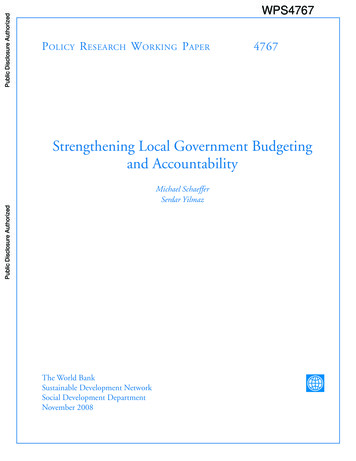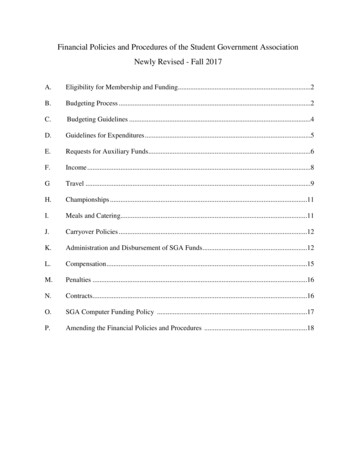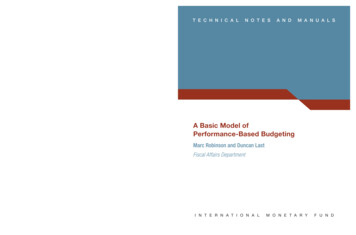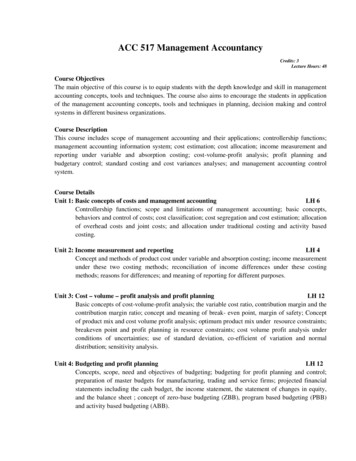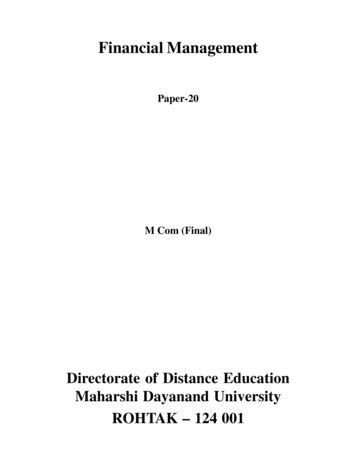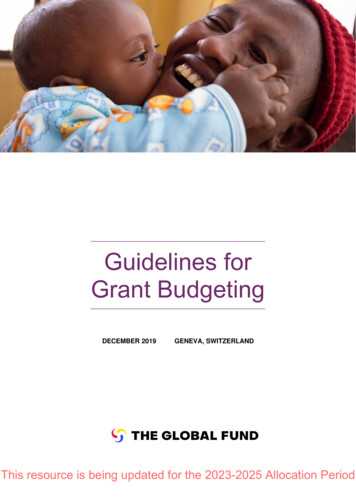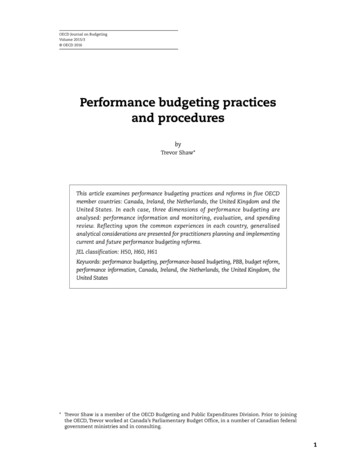
Transcription
OECD Journal on BudgetingVolume 2015/3 OECD 2016Performance budgeting practicesand proceduresbyTrevor Shaw*This article examines performance budgeting practices and reforms in five OECDmember countries: Canada, Ireland, the Netherlands, the United Kingdom and theUnited States. In each case, three dimensions of performance budgeting areanalysed: performance information and monitoring, evaluation, and spendingreview. Reflecting upon the common experiences in each country, generalisedanalytical considerations are presented for practitioners planning and implementingcurrent and future performance budgeting reforms.JEL classification: H50, H60, H61Keywords: performance budgeting, performance-based budgeting, PBB, budget reform,performance information, Canada, Ireland, the Netherlands, the United Kingdom, theUnited States* Trevor Shaw is a member of the OECD Budgeting and Public Expenditures Division. Prior to joiningthe OECD, Trevor worked at Canada’s Parliamentary Budget Office, in a number of Canadian federalgovernment ministries and in consulting.1
PERFORMANCE BUDGETING PRACTICES AND PROCEDURES1. Key findingsOECD member countries have each undergone significant economic and fiscalchallenges of late. This has honed political and administrative attention on getting moreout of public services; often for less money. An emphasis of public finance and expendituremanagement is to now squeeze more out of the budget – durable cash savings, bettervalue-for-money and more accountability, among other things.Performance budgeting tools have been drawn upon to enable these objectives and toassist governments in achieving difficult fiscal goals quickly and responsibly.The challenge for performance budgeting throughout recent time is that a multitude ofdemands are made on the concept (Hawkesworth and Klepsik, 2013). The demands include: Strategy – Provide high-level outcome data that enables the executive leadership ofgovernment to pursue its strategic goals. Accountability – Provide data on activity/process, outputs and – most importantly –outcomes to the parliament, the supreme audit institution and civil society that enablesthese actors to hold the government to account. Transparency – Provide output and outcome data that can be linked with input data in away that provides transparency as to the efficiency and effectiveness of spending so thatbudget officials and parliament can monitor and steer the limited budgetary resourcesto where they matter most in a given political context. Departmental management – Provide input, process, output and outcome data to theline ministers and their secretariats so that they can hold the executive agencies toaccount and have the ability to adjust policies in light of goals and actual developments. Programme management – Provide input, process and output data that enables theprogramme managers to adjust their operations so that services and programmes aredelivered efficiently and effectively.Ideally, a performance system would satisfy all these aspirations. However, this is moreeasily said than done. Each objective requires different types of performance information,held by a mix of organisations, destined for different stakeholders. Indeed, strengtheningone aspect can be detrimental to others. In consequence, most countries have focused ongearing their performance management system towards selected actors’ needs.This paper examines five OECD member countries to identify lessons learned frompast performance budgeting experiences to gain insight into effective practices forperformance budgeting now and in the future. The countries under examination are:Canada, Ireland, the Netherlands, the United Kingdom and the United States.The review structure is broadly the same for each country case: an introduction to theunique fiscal, legislative and institutional circumstances of the country, followed by anexamination of three performance budgeting tools: 2spending reviewOECD JOURNAL ON BUDGETING – VOLUME 2015/3 OECD 2016
PERFORMANCE BUDGETING PRACTICES AND PROCEDURES evaluation monitoring.The study is informed by interviews with budget officials involved in performancebudgeting within the case study countries, as well as the OECD International PerformanceBudgeting Database. The litany of performance budgeting documentation within andoutside each country’s budget institution was fundamental in informing the fact basis ofthis analysis.In each of the case countries examined in this report, it has been many years, evendecades since some form of performance budgeting tactics were first implemented. Yet,the subsequent reforms to the performance budgeting regime in each are numerous,emphasised most recently by broad reforms to performance budgeting systems in many ofthe countries examined in this report proximate to the 2008 global financial crisis.Through these country cases, some common elements of the current state of play inperformance budgeting is summarised in a handful of lessons learned. The commonthread through these lessons is the importance of a systematic view of performancebudgeting. Failures in one aspect (e.g. evaluation) may be caused by weaknesses in others(e.g. weak monitoring data to identify budget-relevant evaluation projects). Consequently,relatively strong functions may not have usefulness in budget deliberations.The burden of proof in budget deliberations can be high. Clear superiority of oneprogramme or project can likely be identified without performance budgeting tools.However, to add value to the system, performance based budgeting attempts to informmore marginal, less certain conclusions.A few generalised conclusions can be drawn:1.1. The executive branch may initiate performance budgeting, but other budgetinstitutions facilitate its successThe executive branch is the body responsible to launch and enable the preponderanceof performance budgeting initiatives, including spending reviews, evaluations andmonitoring. Most commonly, these have been driven centrally by executive branchleadership, though at other times, these initiatives have been a direct response to externalpressure – from the public or parliament.In all country cases in this report, the legislature can, or does provide a vital role inperformance information. In Canada, parliamentary pressure for more information helpedlead to the departmental monitoring structure currently in place and in the United States,Congressional pressure to be more involved in performance target setting was a centralaspect to the recent GPRA Modernization Act reforms.To this end, these efforts have increased the supply of performance informationavailable to parliament and the public. However, the supply of performance information isnecessary but not sufficient to a high functioning performance-informed budgetingsystem. Performance information must be distilled, and provide policy relevance andmeaning. This can be done proactively by departments or the centre of governmentthrough hierarchical whole-of-government programme frameworks and online databasetools. Even still, these measures are rarely enough.OECD JOURNAL ON BUDGETING – VOLUME 2015/3 OECD 20163
PERFORMANCE BUDGETING PRACTICES AND PROCEDURESLegislative budget institutions in each country play integral roles in supporting thelegislature’s role in performance budgeting, namely supreme audit institutions (SAIs) andindependent fiscal institutions (IFIs).Ex ante analysis of performance information is often incomplete or absent in theexecutive branch, but especially the legislative branch of government. Within legislatures,analytical capacity for ex ante analysis of evaluation information is constrained. IFIs arerelatively new in many countries and may assist parliament’s increasing use ofperformance information: By synthesising and putting into context volumes of performance data. By verifying the credibility of the information presented. By nudging existing institutions to improve the usefulness or quality of existing products(i.e. additional detail in budget proposal costings).The SAIs in each country have an important and often more established role than IFIcounterparts. SAIs provide an independent verification of the performance informationpresented by government, increasing the legitimacy and trust in performance informationacross the system, and by introducing alternative pieces of information to round out theperformance picture presented by government.Some SAIs also possess in-house capacity and responsibility for conducting evaluationand can be primary sources of budget-relevant performance information.In the United States, the Government Accountability Office (GAO) audits andevaluations have been cited as contributing to budget development dialogue in both theexecutive and legislative branches. Some GAO publications are informally but annuallyingrained into Congressional committee discussions (e.g. Annual Report on Fragmentation,Overlap and Duplication).In the United Kingdom, the National Audit Office (NAO) undertakes around60 value-for-money studies each year to examine major areas of government expenditure,to form a judgement on whether value for money has been achieved. NAO work can lead todepartments enacting improvements to service delivery or governance, or financialsavings and efficiencies.The legislature and its committees can also play an important role.For example, evaluations can expose weaknesses in programmes, so in theNetherlands there is often little incentive for spending ministries to expose suchinformation, for fear of the information creating a strategic weakness (a potential budgetcut) in trying to better improve a programme or policy. And the Ministry of Financehas limited recourse to ensure evaluations are done in an objective, high-quality,budget-relevant way. Through committee, Parliament has the enforcement andaccountability mechanism lacking in the executive branch in order to ensure thatcomprehensive, budget relevant information (e.g. evaluations) is being generatedobjectively and completely within existing systems and processes.Sceptical legislatures can also slow progress in performance budgeting reforms, justlyor otherwise. In the United States, political divisions between Congress and the executivecontribute to distrust in performance data and obstruct uptake of the performanceinformation being generated. And agency-oriented performance information, notwell-aligned to Congressional votes further discourages legislative use and a performanceoriented budgeting dialogue. Performance information designed for the executive branch4OECD JOURNAL ON BUDGETING – VOLUME 2015/3 OECD 2016
PERFORMANCE BUDGETING PRACTICES AND PROCEDURESis not harmonised to Congress’ decision and accountability structures. Since Congress isan important actor in budget approvals, this inhibits the functionality of performanceinformation feeding through the budget cycle.Finally, parliaments become increasingly engaged when performance information islinked to politically salient issues and priorities. As an example of increased engagement,in the early 2000s, the United Kingdom’s Prime Minister’s Delivery Unit created directlinkages to priority political commitments and goals. These were communicated and putinto action through Public Service Agreements (PSAs). Political attention focused financialresources and the energy of government on a discrete number of measurable objectives,fully reflected in the PSAs, increasing the performance-orientation of budget dialogue.1.2. Evaluations can complement spending review, but so far lack a budget focusProgramme and policy evaluation has enormous potential as an evidence base forbudgeting, yet to date, is rarely consulted in practice. In some cases, evaluation is in anascent stage and is not designed to support budget analysis. Frequently, evaluation isdesigned and used to assist programme managers better understand the performance oftheir programme to comprehend how to do better given resource and policy constraints.These perspectives are legitimate frameworks for analysis, yet this process rarelygenerates the sort of evidence most useful to budget officials – data on the relevance of aprogramme, an understanding of the causal relationship between financial inputs andoutputs/outcomes, and analysis of the efficiency and economy with which programmesdeliver performance.In case study countries where evaluation is more widespread, a barrier to adoptingevaluation data in budget analysis is the decentralised nature under which guidance isprovided and evaluations are undertaken. The CBA rarely drives evaluation policy orpractice. In fact, in some countries (e.g. the Netherlands, Ireland and the United Kingdom)the evaluation function is expressly designed to have a high degree of line ministry input.Understandably, line ministries themselves are most familiar with the idiosyncrasies oftheir programmes and are best positioned to propose the evaluation questions mostrelevant to helping to improve the performance of the programme.However, from the budgeting perspective, information generated in this highlydecentralised way does not provide central, comparable data on performance, thusprohibiting strategic comparisons necessary in budget allocation processes. This may notnecessarily be a consequence of mischievous intentions, but rather a use of evaluationresources most closely aligned with the urgent questions faced by programme managersand ministries. The evaluation output, while uniquely valuable to programme officials, isconsequently not often budget-relevant.Importantly, experiences in case study countries suggest that two importantperformance budgeting pursuits – efficiency and economy – are the weakest aspects ofevaluation analyses. A lack of explicit central guidance requesting the information, as wellas technical concerns (analytical capacity among evaluators and low quality data inputs)were the most commonly cited reason that evaluations fail to provide these budgetoriented pieces of information.Lastly, self-assessments are prone to equivocal explanations, confirming neitherattainment nor shortfalls to an objective. Performance information of this sort has limitedvalue in budgeting at the centre of government. Evaluations conducted as part of aOECD JOURNAL ON BUDGETING – VOLUME 2015/3 OECD 20165
PERFORMANCE BUDGETING PRACTICES AND PROCEDURESFigure 1. Evaluations run by the centre are more frequently used for budgetingthan department-led evaluationLine MinistriesCentral Budget AuthorityPerformance information notcommissioned by governmentStatistical informationLine Ministries performanceevaluationsLine Ministries operational dataand performance reportsSpending review evaluationsLine Ministries financial dataFrequency of useSource: OECD, International Performance Budgeting Database.spending review, usually a centralised initiative run by the central budget authority, areused more frequently in budget negotiations than performance evaluations conducted bythe line ministries, not only by the CBA, but by line ministries themselves.Central guidance and standards may be needed to enable a comprehensive, useful andeffective evaluation regime for budgeting. Considerable resources can be expended onevaluation; however, the impact on budgeting may be limited except for narrow ways.The comprehensive nature of budgeting requires comparability, in basic financialand non-financial ways, across spending items and policies. Highly decentralised,heterogeneous evaluation systems have benefits, potentially to the detriment of centralbudget decision support. Guidance on consistent efficiency and economy questions toconsider across all evaluations could improve the budget-relevance of evaluations alreadybeen undertaken (e.g. Canada’s Policy on Evaluation, and the UK’s Green/Magenta Books).Other strategies may improve the budget relevance of evaluation. Some countries haveintroduced an evaluation cycle, whereby each policy or programme within a segment ofgovernment programme spending should be evaluated over a multi-year period. In Canada,all direct programme spending must be evaluated within a five-year evaluation window.Alternatively, in Ireland, the evaluation period is 3 years for all major blocks of spending.Ireland has also introduced a suite of evaluation tools. Focused Policy Assessments(FPAs) are smaller, less detailed complement to in-depth Value-for-Money Policy Reviews(VFMPRs). The smaller reviews can triage candidate programmes for larger-scale VFMPRsand preliminarily assess specific questions of programme design and delivery.1.3. Transparency is an important goal, but a space is needed for internalperformance-informed dialoguePublic budgeting has historically been an adversarial exercise. Parliament undertakesscrutiny of the executive, which undertakes its own scrutiny from central budgetauthorities to line ministries. Naturally, in an environment of competition and conflict, theprocess is susceptible to strategic and defensive behaviour.6OECD JOURNAL ON BUDGETING – VOLUME 2015/3 OECD 2016
PERFORMANCE BUDGETING PRACTICES AND PROCEDURESIn general, line ministries are subject to the budgeting discretion of others, within andoutside the government. Yet line ministries very often possess a wealth of information onoperational performance, the lifeblood of a functional performance budgeting system.While performance-related information may exist outside line ministries (e.g. nationalstatistics agencies), budget officials and legislators, though influential over financialresources, are frequently subject to the information discretion of line ministries.Given this, line ministry co-operation is essential to an effective system.That being said, many performance regimes have legitimately emphasised thepublication of volumes of performance information to achieve the basic goals ofpresentational performance budgeting: transparency and accountability. While these arenecessary and important goals in performance budgeting, country case experiences haveshown that for systems aspiring for additional performance-informed insights, space mustbe created for a performance-informed dialogue free from scrutiny.If performance information is only and always used as a tool for recourse, there is littleincentive for spending ministries to be forthcoming with potentially self-criticalinformation. Self-assessments are thus prone to explanations that fail to confirmshortfalls to an objective.And if budgets are guided by strict performance information metrics, those metricswill be more susceptible to gaming than if performance information is one of many inputsinto resource choices. Countries that always or usually impose budget freezes or budgetdecrease when performance is not met report higher rates of gaming than countries thatuse budget recourse less frequently.Performance information of this sort has limited value in budgeting at the centre ofgovernment.Figure 2. Gaming of performance targets is more common in OECD countrieswhen budgets are always or usually cut/frozen for poor performanceBudget freezesBudget decreases2.52.01.51.00.50Usually or alwaysSometimes, rarely or neverSource: OECD, International Performance Budgeting Database.In the US system, recent reforms have intended to foster a less adversarialrelationship between the centre of the executive (Office of Management and Budget) andline agencies. Scoring and ranking was removed in an effort to incentivise greater strategicconsultation and performance information flows between the OMB and agencies.OECD JOURNAL ON BUDGETING – VOLUME 2015/3 OECD 20167
PERFORMANCE BUDGETING PRACTICES AND PROCEDURESDuring spending reviews in the Netherlands, pre-specified fiscal ceilings fordepartments diffuse competition over resources and better enable a collaborativeexchange between the spending ministry and the Ministry of Finance. And decentralisingenables financial capacity building in line ministries. This creates pseudo financeministries within departments, serving as a conduit between policy and programmeexperts and the centre.These channels to exchange performance information, free from budget recourse orexternal scrutiny, can enable better flows of information and enhance budget authorities’capabilities to strategically allocate resources.1.4. Uniform performance information regimes are becoming more targetedGovernments at all levels and in many countries have invested enormous amounts todefine outputs, outcomes, impacts, benefits, targets, and so on. With few exceptions,however, [performance budgeting] has not become the government’s budget process.It is an accessory to the budget; it adorns and enhances budget decisions, but does notfundamentally change the way they are made. (Schick, 2014)Performance budgeting momentum has in many cases, slowed under the weight of itsown expectations. The desire to make spending decisions more rationally, using a strongerevidence base is nearly universal. Consequently, many OECD countries have embarked onrounds of sweeping, ambitions performance regime reforms. The ambition has notmatched the effect on functional budget-making.A more selective approach to performance information ambitions is being taken todayin several of the country cases (e.g. in the Netherlands, Canada and the United Kingdom).As an initial step, the number of performance indicators is being consolidated toprovide more meaningful data metrics and reduce onerous reporting burdens.The Netherlands is removing the use of performance information in areas where thecausality between money and results is too weak. Performance budgeting emphasis isbeing focused to programmes and policies where outcomes can be identified governmenthas significant control in achieving the desired outcome and plays an active role in doingso. Areas where outcomes are ill-defined, difficult to measure and where the governmenthas limited control are being de-emphasised in performance. Simply put, if a causal linkbetween money and results cannot be reasonably formed, the Dutch perceive performancebudgeting as a poor fit to policy purpose.Similarly, both the UK and Canadian governments are undertaking internal processesto better benchmark targeted, measureable areas of government operations (e.g. corporateservices). Both are synthesising existing data to develop comparative metrics forcomparable organisations.In Canada, evidence-based management and decision making by allowing newmetrics will aid comparisons of “like” programmes or organisations by providing:8 performance dashboards and heat maps cross-cutting analytical works standardising in clusters of governmental operations benchmarking within and outside of government.OECD JOURNAL ON BUDGETING – VOLUME 2015/3 OECD 2016
PERFORMANCE BUDGETING PRACTICES AND PROCEDURESWhile in the UK, the government has engaged in benchmarking and other forms ofcomparative analysis (e.g. the Comparative Analysis Tool, a solution to visualise financialand performance data of departments; the Performance Platform, which captures dataabout how digital services are performing).Figure 3. The Netherlands’ Accountable Budgeting Conceptual FrameworkLink betweenStrongfunding and resultsPerformance BudgetingPerformance Budgetingbudget links to outcomes and outputsbudget links to outputs onlyGovernment influence on desired resultsStrongWeakPerformance ManagementNeither budget nor managementdisconnected from budgetill-suited for performance regimeWeakSource: Adapted from de Jong (2015).1.5. Senior civil servants’ responsibilities for performance are becoming formalisedNew responsibilities and accountabilities for senior civil servants in governmentorganisations are being introduced to tighten the linkage between organisational and uppermanagement’s accountability and performance. Canada, Ireland, the United Kingdom andthe United States have all introduced new roles or lines of responsibilities for public serviceperformance among senior civil servants.In many cases, unelected officials are being given greater responsibility for theintegrity of the financial accounts of their organisation and have an increased role inexplaining to parliament measures to achieve and improve organisational performance.In Canada, accounting officers have a personal legal obligation to appear beforeparliamentary committees and answer questions on the management responsibilities oftheir department. A similar arrangement for accounting officers exists in in Ireland. Alsoin Ireland, an annual agreement will be signed between a department head and theirrelevant Minister outlining performance objectives.Permanent Secretaries in the United Kingdom have long served as Accounting Officers,responsible as individuals for the efficiency, economy and effectiveness of money spent bytheir organisation. These responsibilities are separate from their service to their Minister, forfinancial management. Recently, new individual roles have been added for performance: awhole-of-government Chief Executive Officer, as well as enhanced performance-orientedresponsibilities for Chief Financial Officers within each spending ministry.The United States has created Chief Operating Officers and other subordinateperformance officer positions within each agency responsible for performance, quarterlyreviews for agency priority goals and overseeing efforts to improve mission-supportOECD JOURNAL ON BUDGETING – VOLUME 2015/3 OECD 20169
PERFORMANCE BUDGETING PRACTICES AND PROCEDURESfunctions. Inter-agency councils of these officers have improved performance-orientedcollaboration.These roles are perceived as an inexpensive, effective way to better align the incentivestructures for organisations and their leaders. In some cases, these positions have helpedto improve the performance dialogue between and within line ministries. However,determining direct causal benefits from these formalised roles, especially early on, aredifficult to distinguish from broader, simultaneous reforms in other areas of performanceand budget.1.6. Spending reviews have proven to be a popular budget tool, but recent historysuggests this popularity may wane under less acute fiscal pressureSpending reviews have been employed by most of the case study countries, with somevariation in comprehensiveness and purpose. Yet, a number of generalizable observationscan be made.Political support, with “buy-in” among government officials is necessary to establishinga clear objective, and a process that can withstand conflicts over scarce resources andpotentially unpopular allocative choices. In Canada’s programme review in the 1990s andStrategic and Operating Review in 2011, the objective was clear to all involved – fiscalconsolidation through spending cuts. In both cases, there was strong political will to realisethis objective. A similarly clear objective and purpose of fiscal consolidation was evidentthroughout Ireland’s 2011 Comprehensive Review of Expenditure.Another defining feature of spending review is the strong central role of the CentralBudget Authority (CBA), as compared to other performance-informed budget processes. Inall cases, CBA officials were central to establishing the rules, procedures and processes ofreviews, but also savings option development and verification. Spending reviews haveprovided a mechanism through which budget officials at the CBA can obtain valuableperformance information that may otherwise not be disclosed in budget negotiations andstrategic budget development. This feature is a natural consequence of spending reviewshaving tighter integration with the budget than many other more decentralisedperformance processes, such as monitoring information or evaluation.Periodic “comprehensive” spending reviews have been notable for the broad spendingscope under consideration. A vital aspect of a comprehensive review is the consideration ofexisting spending along with new spending proposals in a “root and branch” review.These reviews become a mechanism which forces governments to prioritise typically“non-competing” types of spending and can help resist the tendency towards budgetaryincrementalism. However, in many cases, large aspects of government operations have beenexempted from review. Canada’s recent Strategic and Operating Review examined only thedirect programme spending of the federal government, sparing block transfers to subnationalgovernments. In the United Kingdom, annually managed expenditure – programmes such aswelfare, tax credits or public sector pensions – were not part of earlier spending reviewexercises (2007) but have more recently been included in comprehensive reviews in 2010, 2013and 2015. Notably, Ireland’s CRE in 2011 examined previously politically unpopular measures(reductions to social welfare, pensions and public sector pay) to realise large savings goals.10OECD JOURNAL ON BUDGETING – VOLUME 2015/3 OECD 2016
PERFORMANCE BUDGETING PRACTICES AND PROCEDURESFigure 4. Savings yields from spending reviews: Contrasting savings shareson “in-scope” spending vs. total non-interest spending base% of total%16% of United KingdomSources: Government of Canada, Netherlands Ministry of Finance, van Nispen (2015), HM Treasury, author’s owncalculations.Finally, spending reviews as an institutionalised budget tool remains varied. Inthe United Kingdom, spending reviews have been used periodically since 1998.Comprehensive reviews, with a broad scope, have recently systematically been used torealise fiscal contraction in tight fiscal circumstances and achieve strategic goals.Yet, even in the Netherlands, where a cycle of spending reviews is a well-acceptedfeature of the budget process, large scale spending reviews with deep savings options havebeen used infrequently and within a generally constrained fiscal environment. Canada hasperiodically used comprehensive reviews to successfully realise fis
Performance budgeting practices and procedures by Trevor Shaw* This article examines performance budgeting practices and reforms in five OECD member countries: Canada, Ireland, the Netherlands, the United Kingdom and the . account and have the ability to adjust policies in light of goals and actual developments.


